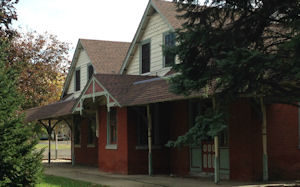by Mark Wallace, Clerk

Merchantville Station
There’s a saying that holding an event once makes it an experiment, twice and the it’s a precedent. But three times makes it a tradition. Our last three January meets held with the NJ Division at the Grace Episcopal Church’s auditorium in Merchantville, NJ is becoming a tradition complete with coffee, donuts, swap tables, a model contest, and more.
Starting off the second Saturday of 2020, at a little past nine o’clock with a few announcements by Superintendents of both Divisions, Jersey’s Fred Willis presented his clinic, “Scratch Building Structures from Photographs.” Fred presented his methods for using photographs to construct or at least make proportional those walls, roofs, windows, doors, and materials on a building that is not a kit. Using photographs in conjunction with a computer to size and proportion has been solid modeling technique. Both Philly Super Charles Butsch and I should know. We’ve been in the construction planning business for years where several of the techniques Fred demonstrated are utilized for model building information where the results can be very accurate. Fred gave some pointers on what is needed for presenting in a contest as well as how to make your model building efforts worthy of a prototypical model. Fred has been modeling the Crystal River Railroad set in Colorado, which was the subject his clinic given at last year’s January meet.
There was an the intermission, followed by more announcements and recognition to our colleagues in the Jersey Division. Then, yours truly, Mark Wallace, presented the morning’s next clinic, the second in his series on The Functional Approach to Model Railroad Dispatching titled, “5 +1 Easy Rules to Model.” This was part two of an ongoing series I’ve been working on as I earn the Chief Dispatcher’s Certificate by doing more than just going thru the motions or form of what a railroad dispatcher does. I’m trying to learn the job’s function as more of a career study that can be “modeled.”
After a kind introduction by Philly Clinics Director Mike Dettinger, we set the theme with a quote by NMRA member Dan Munson from the January 2020 NMRA Magazine, “Watching others operate my layout or my operating on other layouts is the best fun in model railroading.”
As it turns out–and this is a fact–the same functions, methods, and even part of the rule systems that apply to the prototype at 1:1 scale, are also especially suited for model railroading, too! Trains are Dispatched and Conducted. Dispatching is what could be called the purest railroading job to model at any scale. Part two could have been called, “Drivers Ed Rules for Model Railroaders” by taking a half dozen standards and adopting them as your own.
Basics that included “Blocks and Signals,” “What is a Main Line? (and what is not?),” “Turnouts,” “Who Goes First? (Direction, Class, and Right or Authority),” “Main Lines inside Yard Limits,” and “Protecting Your (and the Layout Owner’s) Train–Rule 99,” were covered. There were good questions and lively discussion from the audience. It was near the end where I could see everyone, about 100 of us, really enjoying the conversation. This sharing of how to model “Operations,” where we get to run some sophisticated locomotives or trains in an orderly and prototypical manner that is both fun and exciting to watch, is truly a big thing within the hobby. It was a great group, and thanks for all of your encouraging and engaging remarks.
Shameless Plug: Clinicians – I’m taking some editorial space to encourage everyone to take your model railroading experiences, especially what you are passionate about, and turn it into an article, a talk, show & tell, or presentation clinic to share with the rest of us. You’d be welcome at any meet with a little planning ahead of time. The ability to discuss and share our experiences in model railroading is key to an enjoyable time at a meet. Seeing folks lean into your ideas, make some good points, good comments along with a laugh or two, is what makes these clinics the best. And, you can do them in teams or groups, too!
Shameless Plug No. 2: The FRA – Over in the 1:1 world of the railroad industry or the “prototype,” we model that is both big and powerful has become a lot more user friendly thanks to some changes on the Federal Railroad Administration website. Recent research I’ve done for the occupation of Railroad Dispatcher was easy and rewarding with all kinds of insight for the “non-railroader” (or maybe non-professional railroader). At the end of the article are listed some websites as good starting points for useful information. Booklets on dispatching and other railroading issues that we model are also available. And best of all, with a good internet connection the material is free!
Back at the meet, we finished up the morning with a short show & tell and the door prize drawings. Joe Walters, MMR a 200-ton diesel wreck crane under construction as well as his U.P. rotary snow plow complete with LED lighting. So far the snow has stayed away! We wrapped shortly before noon.
The afternoon featured open house tours at some excellent layouts. There were five on the Jersey side of the river including the Cherry Valley O-Gauge Club located in the church basement. The sixth layout, “The Minnesota Commercial Railway,” was hosted by our own Glyn Thomas, MMR in Philadelphia.
On behalf of the Philly Division a sincere and gracious thank you to New Jersey Division Superintendent Bill Grosse, Jr., Director of Clinics John Gallagher, their crew, and all our friends at the NJ Division for inviting us to co-host the January meet.
